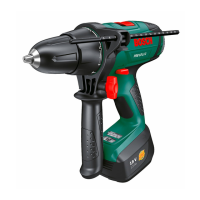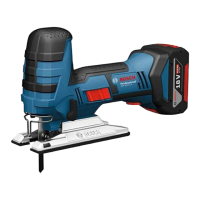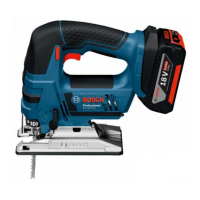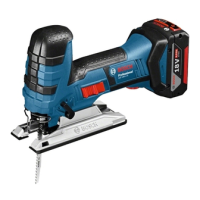Noise emission values determined according to
62841‑2‑11.
Typically, the A-weighted noise level of the power tool is:
Sound pressure level 83 dB(A); sound power level 94 dB(A). Uncertainty K = 5 dB.
Wear hearing protection!
Vibration total values ah (triax vector sum) and uncertainty K determined according to 62841‑2‑11:
Cutting boards with saw blade T 144 D:
ah,B = 11 m/s 2 , K = 1.5 m/s 2 , cutting sheet metal with saw blade T 118 A: ah,M = 10 m/s 2 , K = 1.5 m/s 2 .
The vibration level and noise emission value given in these instructions have been measured in accordance with a
standardized measuring procedure and may be used to compare power tools. They may also be used for a
preliminary estimation of vibration and noise emissions.
The stated vibration level and noise emission value represent the main applications of the power tool. However, if the
power tool is used for other applications, with different application tools or is poorly maintained, the vibration level
and noise emission value may differ. This may significantly increase the vibration and noise emissions over the total
working period.
To estimate vibration and noise emissions accurately, the times when the tool is switched off or when it is running but
not actually being used should also be taken into account.
This may significantly reduce vibration and noise emissions over the total working period.
Implement additional safety measures to protect the operator from the effects of vibration, such as servicing the
power tool and application tools, keeping their hands warm, and organizing workflows correctly.
Rechargeable battery
Charging the battery
Use only the chargers listed in the technical data. Only these chargers are matched to the lithium-ion battery
of your power tool.
Note: The battery is supplied partially charged. To ensure full battery capacity, fully charge the battery in the
charger before using your power tool for the first time.
The lithium-ion battery can be charged at any time without reducing its service life. Interrupting the charging
process does not damage the battery.
The lithium-ion battery is protected against deep discharge by the “Electronic Cell Protection (ECP)”. When the
battery is discharged, the power tool is switched off by means of a protective circuit: The application tool no longer
rotates.
Do not continue to press the On/Off switch after the power tool has automatically switched off. The battery can
be damaged.
Inserting the Battery
Push the charged battery into the battery holder until it clicks into place.
Removing the Battery
To remove the rechargeable battery, press the battery release button and pull the battery out.
Do not use force todo this.
Battery charge indicator
The battery charge indicator indicates the remaining battery capacity or an overload when the power tool is switched
on.
LED Capacity
Continuous lighting 3 x green ≥ 66%
Continuous lighting 2 x green 33–66%
Continuous lighting 1 x green 11–33%
Slowly flashing light 1 x green ≤ 10%
The three LEDs in the battery charge indicator flash quickly when the temperature of the rechargeable battery is
outside the operating temperature range and/or the overload protection has been triggered.

